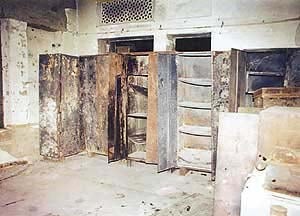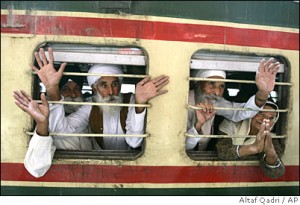
Over the weekend it was reported that two Indian fighter jets violated Pakistani airspace. Although the Indian state is claiming the trespass was inadvertent, it seems that such a move is meant to engage in a ‘psychological escalation’ and pressure Pakistan into taking bolder actions against various militant groups.
However from talking to relatives in India and keeping abreast of the situation through Indian and Pakistani newspapers, it seems that an Indian strike against Pakistan is becoming a foregone conclusion. Anytime India and Pakistan have come to blows, it is the Punjab that is on the frontline. Thus while all South Asians should be aware of the ongoing situation, Sikhs in particular should be paying stark attention. Stratfor has provided an interesting analysis of the situation, which I try to summarize some of the points here.
Deh Shiva bar mohe ihe / shubh karman the khabhu na taro
God, grant me this: that I will never refrain from righteous actsna daroo ar siyoo jab jah laro / nische kar apni jeet karo
That I will fight life’s battles without fear, and will claim victory with courageAr Sikh hao apne hi mum ko / Eh lalch hou guna tau uchroo
That you will be ingrained in my mind / with my highest ambition to sing your praisesJab aav ki audh nidhaan nane / aut hee rann me tab joojh maroo
when this mortal life comes to an end, may I fight with limitless courage
“Deh Shiva” is often described as the Sikh national anthem, and it comes to us from Dasam Granth. As a shabad, it has been invoked on the (literal) battlefield as a rallying cry and a unifying call around Waheguru. The shabad analogizes the struggle in our daily lives to overcome issues that lead us away from Waheguru to a battle — with a single-minded focus on Waheguru, we are able to transcend our attachments to the material and emotional trappings of life.
But as a shabad it has also been used in a very literal manner to mobilize Sikhs in war. As Mewa Singh mobilize action around a political (and militarized) struggle. Does a literal intepretation, or recitation, of shabad convert its meaning? I’ve always found this specific shabad empowering and elevating, but not inherently “violent” or “militant.” As a child, I always felt strangely calm and elated by the words, punctuated at each phrase with “Bole So Nihal, Sat Sri Akal!” I have always heard this shabad as a call to the nation, not as a device or tool for violence.
We’ve heard the arguments (valid and not) before about why Sikhi is a martial faith or has a martial history or a martial outlook. There are certainly religious foundations that acknowledge the real challenges faced in every day life and the need to resist oppression. Resistance eschews, but does not forbid, violence. Nonetheless, at its core I believe Sikhi is a religion of love — love of the Guru, Granth, and community, defined in the context of humankind and creation.
As many Punjabi Sikh homes across America celebrated Thanksgiving with the traditional Turkey dinner with all the fixins, chollaa puraa with a side of dhaee, or chicken/turkey cooked in good old Masalaa, I wonder about our internal struggle to feel “American”.
Although much of Jhumpa Lahiri’s work [previous TLH coverage] focuses on the issues encountered by middle to upper-middle class immigrant Indians and their children (i.e. Bengali) in America, her recent NPR interview on the struggle to feel “American” can resonate across the immigrant experience. Thus, complicating the notion of what it means to be “American” in the first place.
As a child of Indian immigrants born in the West, Lahiri says “there is sort of a half-way feeling [of being American]” for her.
However, her parents never thought of themselves as American:
“…they’ve lived here now for more than half of their lives, and they raised a family here and now have grandchildren here. … It has become their home … but at the same time, for my parents, I don’t think either of them will ever consciously think, ‘I am an American” [both are American citizens].
Jodha previously blogged about national-level elected Sikh leaders and rightfully noted the low representation of leaders from the UK. This week, Councillor Gurcharan Singh was chosen to represent the Conservatives as the Parliamentary Candidate for Ealing Southall. Ealing Southall has one of the highest proportions of Sikhs in any constituency in the UK and contains the Sri Guru Singh Sabha Gurdwara, one of the largest Sikh 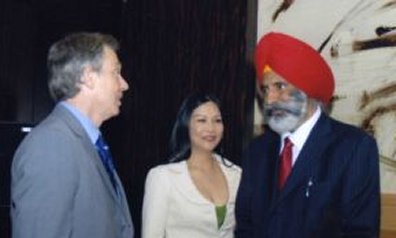 temple’s outside of India. Chairman of the Ealing Southall Conservative Association, Manjit Singh notes,
temple’s outside of India. Chairman of the Ealing Southall Conservative Association, Manjit Singh notes,
“The people of Ealing Southall are fed up with Labour and want an MP who can make a difference. After the next election we will have a new Conservative Government led by David Cameron and a new Conservative MP for Ealing Southall in Gurcharan Singh. I look forward to taking our message to the voters and getting rid of this tired Labour Government and the local MP who is more interested in collecting his allowance than in serving residents.” [link]
Interestingly, Gurcharan Singh was one of five representatives who left the Labour party last year to join the Conservative party. Gurcharan Singh moved to the UK in 1972 and originally joined the Labour Party in 1976 and became a councillor in 1982. Last year, the Labour party faced internal division over their candidate selection and following Virendra Sharma’s selection several Sikh Labour councillors, led by Gurcharan Singh defected to the Conservative party. In June 2007 (and in the picture above with Tony Blair – Labour party) Gurcharan Singh said,
“I am full of hope for the future as this to me signals the beginning of an era where the Labour party can consolidate its leanings over the last few years and move forward with a new outlook based upon positive change. We progress.” [link]
In my last post, I argued that terrorists, by their actions, sever any legitimate relationship with a religion and any recognized sovereign, and as such terrorists should be identified as terrorists (e.g., “terrorists have invoked an interpretation of Islam to justify their actions”), even if the terrorists use religion or a disputed regional policy as a justification for their acts. Note that the focus of the proposition is identification of terrorists, and that its purpose was to suggest ways in which a backlash against all Muslims in India could be avoided.
This post generated a significant and spirited reaction. For example, some contended that my argument was typical of the left, of apologists, and of those who fail to understand the demonstrated link between Islam and terrorism. In response, and consistent with the fact that it’s exam time in classrooms and campuses across America, I ask the following:
Who made these statements:
“Ours is a war not against a religion, not against the Muslim faith. But ours is a war against individuals who absolutely hate what America stands for[.]”
“Americans understand we fight not a religion; ours is not a campaign against the Muslim faith. Ours is a campaign against evil.”
“The enemy of America is not our many Muslim friends; it is not our many Arab friends. Our enemy is a radical network of terrorists[.]”
“[T]he war against terrorism is not a war against Muslims, nor is it a war against Arabs. It’s a war against evil people who conduct crimes against innocent people.”
And the kicker:
This enemy tries to hide behind a peaceful faith. But those who celebrate the murder of innocent men, women and children have no religion, have no conscience and have no mercy.
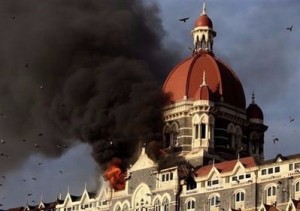 The terrorist attacks in Mumbai — which consisted of blasts in at least seven sites and which apparently targeted Westerners — have, as of this writing, claimed over 110 lives and injured a minimum of 300. Terrorism on this scale has the tendency to engender very common, basic reactions: fear of another attack, concern for those who are at or near the location(s) of the attacks, care for friends or family who may have loved ones affected, disbelief that one set of humans can do this to other humans, and an interest in why the terrorists did what they did. All these elements were present in the wake of 9/11 and the 7/7 bombings, and I believe have been resurrected again with the Mumbai attacks.
The terrorist attacks in Mumbai — which consisted of blasts in at least seven sites and which apparently targeted Westerners — have, as of this writing, claimed over 110 lives and injured a minimum of 300. Terrorism on this scale has the tendency to engender very common, basic reactions: fear of another attack, concern for those who are at or near the location(s) of the attacks, care for friends or family who may have loved ones affected, disbelief that one set of humans can do this to other humans, and an interest in why the terrorists did what they did. All these elements were present in the wake of 9/11 and the 7/7 bombings, and I believe have been resurrected again with the Mumbai attacks.
There is another aspect of a response to mass terrorism that I’d like to discuss in this post: the inclination to unfavorably treat those who share characteristics with or bear resemblance to the terrorists. Following 9/11 and 7/7, Muslims and those perceived to be Muslim were subject to a pervasive and violent backlash. (As we reported earlier this week, Sikhs in America have been profiled in the airport setting.) Accordingly, with news accounts suggesting that the Mumbai terrorists are Muslim, some are worried that Muslims in India may face a wave of public and/or private harassment and discrimination. For example, a colleague who heads a major civil rights organization in America expressed that he was “praying for victims of [the] Mumbai attack[s] and for Muslims in India.”
It should not have to be this way.
A retelling of Heer Ranjha is set to launch in Glasgow this week, and the screenwriters have done a fascinating job of trying to place the classic love story in a contemporary setting.  Instead of the story of two villagers (Ranjha, who leaves his home and is hired by Heer), it’s the story of a Muslim restaurant worker and a Sikh socialite:
Instead of the story of two villagers (Ranjha, who leaves his home and is hired by Heer), it’s the story of a Muslim restaurant worker and a Sikh socialite:
In a fit of depression, [Ranjha] throws himself off the George VI bridge, presumably choosing that one ahead of the Kingston so that the play can continue. He is pulled out of the Clyde by a boatful of partygoers, led by the beautiful Heer, the fast-living daughter of a Glasgow curry magnate and a Sikh. [link]
And, instead of fully morphing the play, the director discussed his desire to speak directly to the Asian population in Glasgow. He integrates a fully Punjabi story into the framework of life experience for Punjabi Scots, including choosing to play the dialogue in local dialect:
“I had been trying for some time to find a story that would attract Asian audiences [Glasgow’s Asian community is primarily Punjabi] and Heer Ranjha was something I had come across very frequently in my discussions with [local] people,” says Lalitha Rajan, artistic director of Ankur Productions. “I wanted to make it relevant and contemporary and I wanted a writer who had an ear for Glaswegian dialect, because it has its own unique linguistic richness. [link]
I think one of the most striking features of this show the opportunity it takes to speak to, and honor, the interconnectedness of the history of Scotland’s Punjabi community within the artistic/social narrative of the U.K. Instead of the story feeling unfamiliar, exotic, or far, it is re-placed to popularize it among youth in the diaspora. Whether this means it’s more risque or departs dramatically from the original, I’m curious to see how it turns out. If any of our readers are Scotland-based, I would love to hear a review if you’re able to go!
 My Nana Ji (maternal grandfather) often says: “Ja savair da bhulia, shaam noo ghar muriavye, ta oh nu bhulia nehee keheeda”. That if one is lost in the morning, but finds his way home by evening, he’s no longer lost. Hopefully that’s the case with Sikhs and their preservation of history and architecture.
My Nana Ji (maternal grandfather) often says: “Ja savair da bhulia, shaam noo ghar muriavye, ta oh nu bhulia nehee keheeda”. That if one is lost in the morning, but finds his way home by evening, he’s no longer lost. Hopefully that’s the case with Sikhs and their preservation of history and architecture.
Over the years, well-intentioned but individuals kar sewa babas took on the responsibility for the renovation and expansion of Sikh religious institutions across South Asia. Unfortunately, in almost every case, they lacked any expertise in preservation and caused way more harm then good. The result has been, literally, a whitewashing of Gurdwaras. With an “out with the old and in with the new” attitude, old historical structures have been torn down, modified beyond recognition and historical paintings and frescos have been painted or tiled over.
For me the most shocking example of this came from the Baba Atal tower in Amritsar, where hideous green bathroom tiles (that no self-respecting homeowner would ever use) were installed over top of century-old paintings. Here is pic that were sent my way a few years back.
Thankfully, someone has woken up to the fact that bathroom décor isn’t the best way to preserve our history for future generations.
The heritage experts engaged by the SGPC and the district administration have found priceless frescoes from the first floor of Baba Atal, the tallest building of Amritsar, hidden under bathroom tiles put up by Sikh Babas during previous kar sewa.
The art work is exquisite. Most of the art work, hidden during the kar sewa can be retrieved though it requires extra care and expertise. The experts are careful that further damage is not caused while removing marble or bathroom tiles.
Earlier, the SGPC had entrusted kar sewa to the Sikh Babas who had “destroyed” the Sikh heritage, much to the chagrin of experts. Deputy commissioner Kahan Singh Pannu today held a meeting with experts in the Golden Temple complex after monitoring the restoration work of Baba Atal and Ramgarhia Bungas.
Earlier, the kar sewa, carried out to repair age-old murals at Gurdwara Baba Atal, had earned flak from heritage lovers. Interior walls of the first floor were adorned with murals depicting Sikh history. About 100 panels of murals had been left on the first floor of the gurdwara, while the rest of them had been destroyed beyond recognition. Link
This is an area where the Sikh diaspora can have a direct impact. Most kar sewa efforts are highly dependent on dollars and pounds coming in from abroad. Before giving from your dasvand to these causes, please make sure and find out what the project is actually doing. The last thing anyone wants to further devastate the little physical we have left.
I know that we Punjabis love importing our culture and traditions to the countries we now call home, but this is getting ridiculous.
Brampton city councillor Vicky Dhillon is on a crusade to stop stores in his area from selling two kinds of decorative poppy flowers, which he said contain addictive opium.
Dhillon said the flowers and stalks are ground into a brownish powder — called doda — that is openly sold for about $10 for 10 grams at about eight meat stores in his Wards 9 and 10. The powder gets a person high when mixed with water and ingested, he said. “This drug is causing a lot of problems in the community,” said the councillor, adding it’s largely used in the Sikh and Hindu communities. His ridings contain more than 100,000 Sikhs.
Dhillon said he’s concerned the use of doda will spread to area schools due to its low cost. Peel Regional Police raided several businesses two weeks ago that were allegedly selling the drug. One man was arrested and 38 kilos of doda seized. Dhillon said he’s raised his concerns with Peel and Brampton city councils and health officials are looking into the problem.
Several varieties of poppies are allowed into Canada as decorative flowers, but only a few have a high opium content. Dhillon is calling for a ban on sales of two specific poppies — Arizona and Holland. “In the last two years, the use of doda has exploded,” he said yesterday. “This is a big threat to the younger people in our community.” Some of the stores selling the “ornamental flowers” were conducting brisk business yesterday. (Link)
I guess I should not be surprised. If drug use is at epidemic levels in Punjab, its naïve to assume people are going to magically clean up their act when the come to Canada. In fact, the culture shock, isolation and life changes that usually come with immigration, probably only make existing drug dependencies worse.
I was always amazed by the number of “meat shops” in Punjabi communities across Canada. I didn’t think there was enough demand for specialized Punjabi meat products to justify the supply. What I hadn’t taken into account was the “premium products” offered at the back of the store.
On the topic of gurdwara construction, the El Sobrante Gurdwara here in the Bay Area recently had its on-site expansion authorized by the county Planning Commission [link]. The gurdwara is located in unincorporated territory, so it’s not controlled directly by city government, and it’s petitioned for expansion plans to be approved for almost 10 years. For a sense of geography, the gurdwara was the first Bay Area facility for a large (and ever-growing) Sikh community, and it’s located on a relatively large site on the face of a huge hill with residential properties above and a commercial and transit corridor at the foot of the hill.
Gurdwara Sahib, the Sikh Center of San Francisco Bay Area, plans to build a community center, performing arts center, museum and parking garage on its 6.5 acre property off Hillcrest Road in unincorporated El Sobrante.
The expansion would add about 70,000 square feet, not counting the garage, to the existing temple’s roughly 22,000 square feet.
I have my own mixed feelings about the expansion, it’s enormity, and the capacity of the site/land to sustain the traffic and population, particularly during an earthquake. That said, the part of the article that really stuck out to me were complaints from local residents, who have opposed the expansion since its first enlargement in the mid-1990s:
Henderson said the commission failed to address his neighbors’ and other El Sobrante Valley residents’ concerns about traffic, noise and the area’s history of landslides, among other environmental concerns.
He also has said that the temple expansion would obstruct homeowners’ views of the Bay among other aesthetic objections, and has called for a full Environmental Impact Report.
“America has elected a black president but it is still business as usual,” Henderson wrote on Wednesday. The commission “has decided that the reasonable requests of the Quail Hill residents are of no concern. “Could it be because the people most affected are primarily black? [emph. mine]
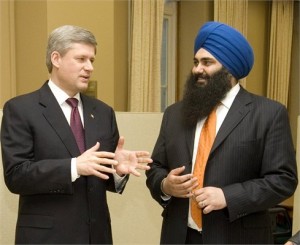 It’s a dark and story night in northern Alberta city of Edmonton. Preparing for a national election that is still months away, the Conservative Party’s riding association in Edmonton-Sherwood is having its nomination meeting. Its not expected to be eventful, as everyone expected local municipal councillor Jacquie Fenske to win by acclamation. On the last day, a young man walks in with his supporters and also declares his intentions to contest the riding on behalf of the Conservative party. He happens to come prepared with more supporters than the surprised Fenske and ends up winning the nomination. A supporter of the exiled Fenske, James Ford contests as an independent but is defeated by the official Conservative candidate as part of an overall minority government win by the Tories.
It’s a dark and story night in northern Alberta city of Edmonton. Preparing for a national election that is still months away, the Conservative Party’s riding association in Edmonton-Sherwood is having its nomination meeting. Its not expected to be eventful, as everyone expected local municipal councillor Jacquie Fenske to win by acclamation. On the last day, a young man walks in with his supporters and also declares his intentions to contest the riding on behalf of the Conservative party. He happens to come prepared with more supporters than the surprised Fenske and ends up winning the nomination. A supporter of the exiled Fenske, James Ford contests as an independent but is defeated by the official Conservative candidate as part of an overall minority government win by the Tories.
You would expect an initial uproar as a young and upcoming catches the old guard off guard, but things should eventually settle down. However, when there’s still protests more than a month after the election, you know there’s more to this story.
So what’s different? A beard and a turban. These articles of the Sikh faith belong to Tim Uppal, a young Sikh activist who has been spent his entire life on the political scene in Edmonton and had previously contested two other elections and lost in a different riding.
I spent the past weekend surrounded by Sikh Art and Film at the annual Spinning Wheel Film Festival in Hollywood. I usually attend these events with high expectations, hoping to be inspired and moved and there are always one or two films that provide that sustenance. The films were creative, such as The Making of Liverpool – an artistic animation inspired by a painting by The Singh Twins which explores 800 years of Liverpool’s history. The films were educational, such as Cultural Safari – directed by Sandeep Singh and produced by the Kaur Foundation – describing the basics of Sikhi for children of all ages [I have to say that this is one of the most impressive educational films I have come across]. The films were also daunting, such as Warrior Boyz – made by Baljit Sangra which touched upon the root causes of gang violence in the Punjabi community of Vancouver. A favorite of the crowd was Kuldip Powar’s Unravelling – a poetic inter-generational dialogue between the film director and his grandfather about the experience of war all posed in Urdu poetry.
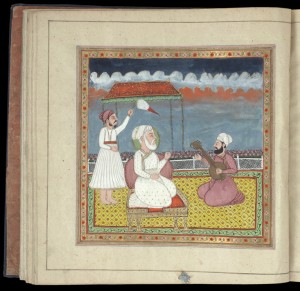 There were many other well-made films such as 35, Kabaddi Cops, and Right to Turban which rightfully deserve mention (and have been discussed or will be discussed in future posts), however what I appreciated most about the weekend was the final day of the festival – which was devoted to lectures on Sikh Art and History. Staff from the Anglo Sikh Heritage Trail and other UK-based organizations presented the attendees with a glimpse into the historical legacy of the Sikhs. One of the lectures was titled the Epic of Saragarhi and discussed the 21 soldiers of the Sikh regiment who defended a remote post against an estimated 10,000 hostile tribesmen. Michael O’Keefe from the British Library discussed Sikh artifacts and paintings and detailed an image of Maharani Jindan Kaur’s Gutka of the Sukhmani Sahib (see picture to the left). The day ended with a panel showcasing Sikhs in Theatre and Music, including traditional music and also hip-hop. Mandeep Sethi and Jagmeet Singh, rappers from LA, ended the festival with amazing performances showcasing their incredible talent of telling stories through hip-hop.
There were many other well-made films such as 35, Kabaddi Cops, and Right to Turban which rightfully deserve mention (and have been discussed or will be discussed in future posts), however what I appreciated most about the weekend was the final day of the festival – which was devoted to lectures on Sikh Art and History. Staff from the Anglo Sikh Heritage Trail and other UK-based organizations presented the attendees with a glimpse into the historical legacy of the Sikhs. One of the lectures was titled the Epic of Saragarhi and discussed the 21 soldiers of the Sikh regiment who defended a remote post against an estimated 10,000 hostile tribesmen. Michael O’Keefe from the British Library discussed Sikh artifacts and paintings and detailed an image of Maharani Jindan Kaur’s Gutka of the Sukhmani Sahib (see picture to the left). The day ended with a panel showcasing Sikhs in Theatre and Music, including traditional music and also hip-hop. Mandeep Sethi and Jagmeet Singh, rappers from LA, ended the festival with amazing performances showcasing their incredible talent of telling stories through hip-hop.
While the film festival brought together a plethora of Sikh art mediums – what it did seem to be missing was the representation of women and the voice of women in these films. The films were predominately made by men and the issues discussed were predominately issues affecting men. This brought several issues to mind – do young Sikh women not feel encouraged to enter the field of Film? Do the current male Sikh filmmakers not feel comfortable telling the story of Sikh women? It seems to be of vital importance that as we develop and promote Sikh films, we ensure that the stories we tell are representative of the entire Sikh panth and pay particular attention to the stories of Sikh women.
I will leave with this quote, mentioned by Harbinder Singh of the Anglo Sikh Heritage Trail, but also very pertinent to the theme of this weekend’s film festival.
Until lions tell their own history,
History will always glorify the hunters.
– African Proverb

“The first step in liquidating a people is to erase its memory. Destroy its books, its culture, its history. Then have somebody write new books, manufacture a new culture, invent a new history. Before long that nation will begin to forget what it is and what it was… The struggle of man against power is the struggle of memory against forgetting.” – Milan Kundera, The Book of Laughter and Forgetting
Sikhs have never been big on preservation. Partly because we’ve spent most of our 500+ year history fighting for very existence, but in recent years its been a greater combination of complacency, incompetence and real external efforts to mess with our past. All of this has contributed to a situation where, it has been said by some experts, that 80% of Sikh history (architecture, artifacts, texts, etc) has been destroyed in the last 100 years.
According to a 1968 publication of SGPC called ‘sada hath likhat sahit,’ the Sikh Reference Library contained 383 volumes that covered 980 different topics. Amongst this repository were several Hukamn?m?s, 2500 hand-written sarups of Guru Granth Sahib, and other rare historical documents. One historical document was written by Bhai Gurdus and bore a hand-written Mul Mantr page by the Ninth Nanak.
The library also consisted of a manuscript dated 1739 Bikram? that was prepared by Guru Gobind Singh Sahib five years after the martyrdom of Guru Teghbahadur Sahib – in this document, the Tenth Nanak added the writings of the Ninth Nanak at Damdama Sahib to the Guru Granth S?hib.
Unfortunately, the Indian Army set the building on fire on June 7, 1984, destroying a majority of these rare documents. In recent years, the Indian Defense Minister has also admitted to the burning or removal of material from the Sikh Reference Library.
As a young kid, the langar hall was my favourite space in our local Gurdwara. Located in the basement of the building, it was a home away from home. My parents helped build the Gurdwara in the 1970s and I spent many weekends helping with the preparation of Sunday morning langar. I occasionally helped with the cooking, often with the serving and always with the running around. The wide open empty space in the hall provided many hours of fun with playing tag and football with a ball made of tied-up ramaals (handkerchiefs). It was a place to hang out with kids that looked like me and who were going through the same things as me.
As I moved through my late-teens and what I affectionately call my “hard-core” phase, I saw the langar hall as a place serving only two specific functions; serving meals and eating meals (on the floor). Idle social conversation wasn’t what you were going to Gurdwara for. You could do that during the famous multi-family dinner parties that all Punjabi parents dragged their kids to. Gurdwaras were for serious matters and all these people sitting around and gossiping were just taking up valuable time space. Thankfully, I lightened up.
Fast forward a decade (or two) and now, I’ve reconciled my past. Growing up, while I was hanging with other kids who called “jooda time-outs”, the adults were also drinking chaa, talking and sharing stories with other adults. Through the universal acts of serving a meal and sharing a meal, the langar hall became a hub for my local Sikh community.
I’ve seen many an animated conversation in a langar hall. I’ve seen people talk with passion about faith, family, politics, business, sports. In fact, aside from the langar hall, our community has few other forums that provide for all walks of life to come together and share their ideas.
That is why I love that the Langar Hall has gone online. In the same spirit of my community Gurdwara, this site brings together ordinary Sikhs to talk about the issues of the day. The only difference here is that you have to supply your own chaa and mutheai (how the heck do you write that in English? Its worse than paranthas).
I’ve been asked to take on the seva of contributing to this great project. I do not have an English degree from a fancy American university like my illustrious colleagues, in fact I probably should have taken up my Grade One teacher’s offer of English as a Second Language classes. Regardless, I will promise to add another voice to the conversation. Not one that is highly educated or representative of all Sikh-Canadians but one of a second generation Sikh-Canadian born and raised in a country he loves as his own.
Let the gup-shup begin!
In a recent THL discussion on Prop. 8 we have been addressing the use of Sikh principles in taking a position on homosexual marriage.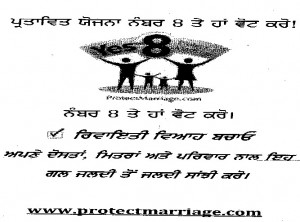 At a recent Nagar Keertan in Yuba City, California there were “Yes on Prop. 8” fliers along with the really interesting T-shirts. Thus, I think religion is an important part of the discussion on Prop. 8 because there is a reason why this state-related material is at religious events. Religion is a moral compass that guides many people’s decisions in all kinds issues. Thus, I don’t condemn those who have used religion as their moral source for voting Yes or No on Prop. 8. However, I do disagree with how Sikh scripture has been misused as “rules” rather than concepts that guide our decisions. I attribute these actions to a general lack of understanding and education around the Guru Granth Sahib Ji in our community. This education is a fundamental issue we as a Quam need to find practical solutions for rather than blame people for not knowing.
At a recent Nagar Keertan in Yuba City, California there were “Yes on Prop. 8” fliers along with the really interesting T-shirts. Thus, I think religion is an important part of the discussion on Prop. 8 because there is a reason why this state-related material is at religious events. Religion is a moral compass that guides many people’s decisions in all kinds issues. Thus, I don’t condemn those who have used religion as their moral source for voting Yes or No on Prop. 8. However, I do disagree with how Sikh scripture has been misused as “rules” rather than concepts that guide our decisions. I attribute these actions to a general lack of understanding and education around the Guru Granth Sahib Ji in our community. This education is a fundamental issue we as a Quam need to find practical solutions for rather than blame people for not knowing.
That said, I believe a fundamental part of Sikhi is love … the morality of love. It’s not the happy happy love or perfect one that excuses all actions, but the one that makes us human enough to see the light of Waheguru in all …. even those we detest. What is this love … I think Khalil Gibran poignantly explains it in his book “The Prophet”:
“For even as love crowns you so shall he crucify you. Even as he is for your growth so is he for your pruning. Even as he ascends to your height and caresses your tenderest branches that quiver in the sun, so shall he descend to your roots and shake them in their clinging to the earth.”
Pakistan-bound Sikh devotees wave to relatives as they depart by a special pilgrimage train in Amritsar, India. Hundreds will journey to the birthplace of the first Sikh guru, Guru Nanak Dev, in Nankana Sahib, to celebrate his birthday.
[Photo by Altaf Qadri]
The elections are over, but even after the last card has been punched and the last absentee ballot counted, the political fervor that they ignited is still alive. While the country took two steps forward on its march towards complete civil rights by electing its first African American president , it took a step back by taking away the rights of particular individuals. California’s Prop. 8 received national attention (no surprise with more than $70 million in campaign spending). The proposition reversed a ruling from the California Supreme Court, which earlier this year declared that banning same-sex marriages was discriminatory. Prop. 8 – which passed albeit by a hair – will for the time being change the state constitution to define marriage as only between a man and a woman.
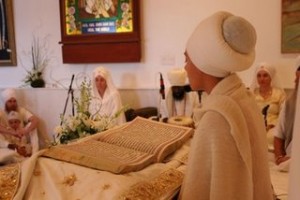 People feel really passionate about this topic. Really really passionate. What interests me the most, however, are the arguments for and against same-sex marriages and particularly what it does or does not say in the Sri Guru Granth Sahib about this topic. People are actually using words from the Sri Guru Granth Sahib to make their point – and I’m not sure that’s legit. In fact, I’ve been following a heated discussion on a certain social networking site where young Sikh individuals have been going back and forth about what voting for or against Prop. 8 means. The most common argument against same-sex marriages is that in the Sri Guru Granth Sahib it states that marriage is the union of two souls, husband and wife, man and woman, male and female. The other side of the argument is that Sikhi advocates equal rights for all and the Sri Guru Granth Sahib does not specifically make any comment on same-sex marriages. However, there seems to be a lot of ambiguity as to what is actually said. One reference states,
People feel really passionate about this topic. Really really passionate. What interests me the most, however, are the arguments for and against same-sex marriages and particularly what it does or does not say in the Sri Guru Granth Sahib about this topic. People are actually using words from the Sri Guru Granth Sahib to make their point – and I’m not sure that’s legit. In fact, I’ve been following a heated discussion on a certain social networking site where young Sikh individuals have been going back and forth about what voting for or against Prop. 8 means. The most common argument against same-sex marriages is that in the Sri Guru Granth Sahib it states that marriage is the union of two souls, husband and wife, man and woman, male and female. The other side of the argument is that Sikhi advocates equal rights for all and the Sri Guru Granth Sahib does not specifically make any comment on same-sex marriages. However, there seems to be a lot of ambiguity as to what is actually said. One reference states,
[The Sri Guru Granth Sahib] is seemingly silent on the subject of homosexuality; however, married life is encouraged time and time again in Guru Granth Sahib Ji. Whenever marriage is mentioned, it is always in reference to a man and a woman. Some Sikhs believe that Guru Granth Sahib Ji is the complete guide to life, and if a marriage between two of the same sexes is not mentioned, it is therefore not right. The counterargument to this is that man and woman are only mentioned in this way to give light to the relationship of the soul and the soul force as being one. This denies gender and sex as an issue. Thus, Sikhism is more concerned with ones attainment of enlightenment rather than habitual desires such as sexuality. True love is attained through the Guru and no man speaks on behalf of the Guru as the Granth is open to interpretation and misrepresentation. [Link]
 As I searched the Internet for information on the 2008 Diwali celebration at the Golden Temple, I came across this video on YouTube. It shows a beautifully lighted Golden Temple complex, with fireworks going off in the nighttime sky. My joy at watching the visuals soon turned to discomfort in hearing the sounds — the cracking of the fireworks reminded me of gunshots, gunshots that went off in that same area over twenty-four years ago.
As I searched the Internet for information on the 2008 Diwali celebration at the Golden Temple, I came across this video on YouTube. It shows a beautifully lighted Golden Temple complex, with fireworks going off in the nighttime sky. My joy at watching the visuals soon turned to discomfort in hearing the sounds — the cracking of the fireworks reminded me of gunshots, gunshots that went off in that same area over twenty-four years ago.
As I thought about the horror of Operation Blue Star and the subsequent anti-Sikh riots in Delhi, a friend relayed this disturbing and upsetting news: the Indian Army finally admitted last month that Sikh soldiers were among those killed in the anti-Sikh pogrom. Up until last month, the Indian Army reportedly hid the names of the soldiers who were killed in the riots. In fact, the government allegedly “hatched a conspiracy to hush up [the] matter by labeling the soldiers as deserters.”
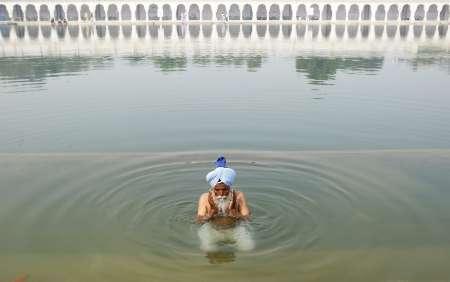
A Sikh devotee offers prayers at a gurudwara in New Delhi November 5, 2008.
REUTERS/Francois Lenoir (INDIA).
I almost can’t believe it. One newscaster announced “Barack Hussein Obama has just become the 44th President of the United States” and I burst out laughing.
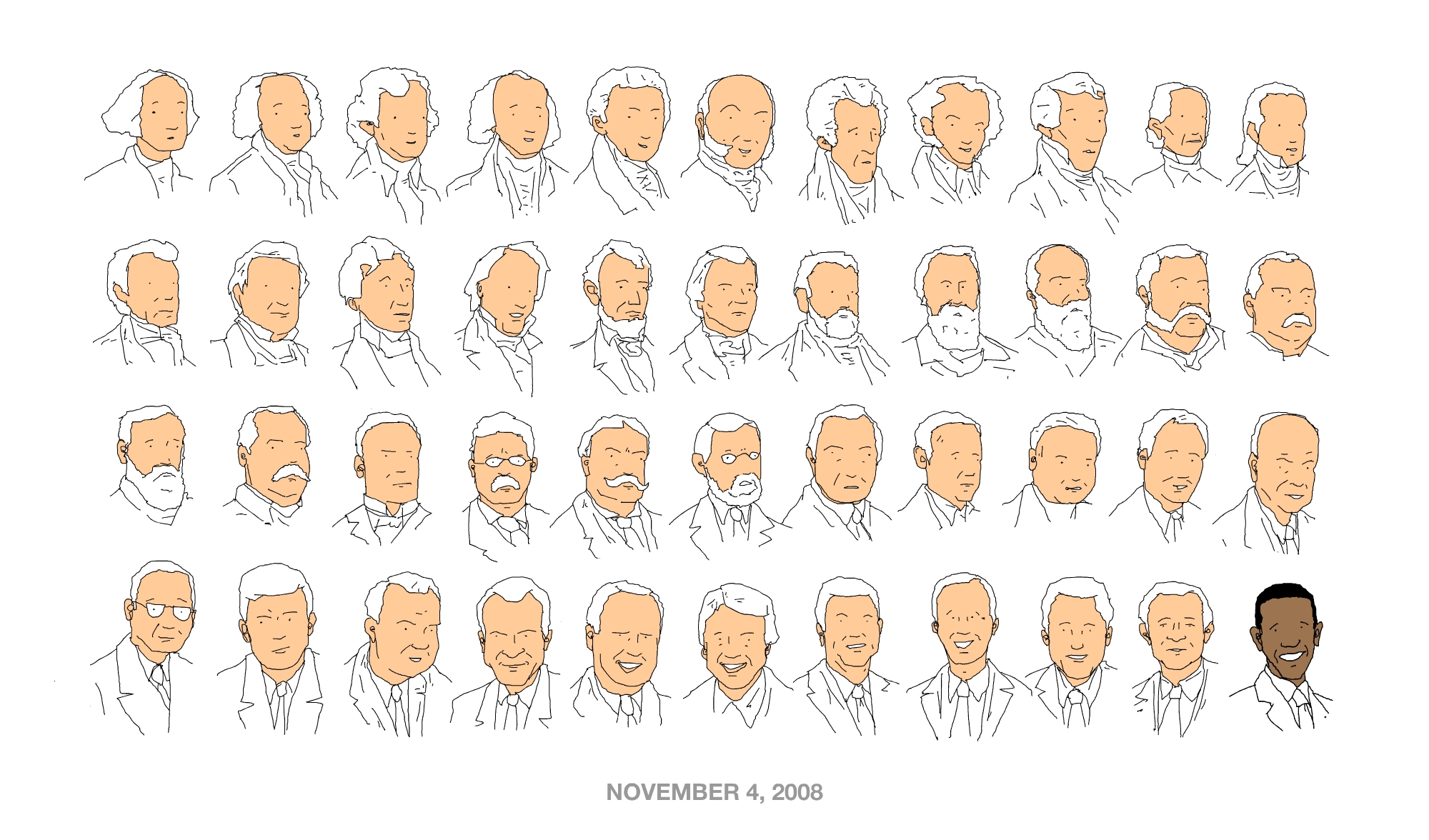
Someone pinch me.
As all the headlines read- history was made last night.
I’m awed by the level of civil participation that we’ve witnessed over the last few months (and for some, since the primaries). Family and friends have been making phone calls, going door to door even yesterday, were poll monitors… it’s been wonderful to witness. One friend was mentioning that in the 60s, they used to protest for really innocuous things- like asking for a law that was already in place to be implemented. But it was the act of organizing that authorities found threatening.
Now I’m curious as to what changes this administration will actually bring, what it will mean for Sikhs, for minorities, for women.
I’m assuming that people have a lot on their minds right now. Let’s try an open thread. Feel free to comment on whatever last night’s results have brought to mind.
(Illustration by Patrick Moberg, thanks Gurpreet for the link!)
